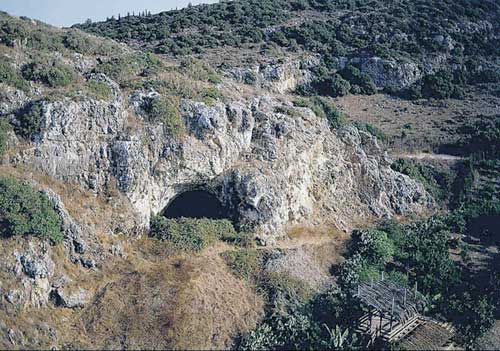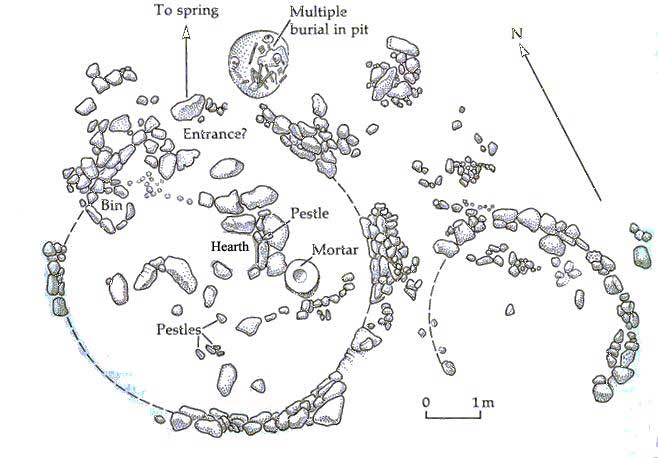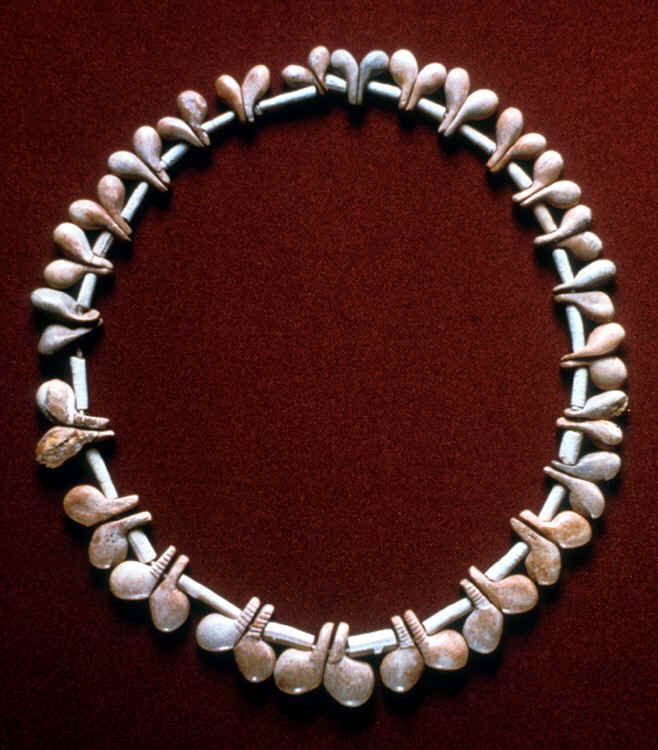

GENERAL CHARACTERISTICS OF THE LATE UPPER PALEOLITHIC AND EPI-PALEOLITHIC PERIODS: RAPID CULTURAL CHANGES
1. increase in number of open sites and decrease in cave occupations
2. population increases
3. trend toward generalized subsistence
4. intensification of plant use, especially domesticate progenitors
5. specializations in hunting, especially domesticate progenitors plus gazelle
6. increased use of aquatic resources where available
7. increase in number of ground stone and bone tools, suggesting changes in settlement-subsistence systems
8. increase in composite tools
9. increased use of "facilities" (storage pits, ovens, etc.) as opposed to just "implements" for subsistence
10. experimentation with baked clay objects
11. more year-round settlements in Levant, still mostly seasonal in Zagros although are some villages (due to environmental differences)
12. increase in burials
13. increase in representation art
14. egalitarian bands or tribesLEVANT AREA - KEBARAN CULTURE
10,000 to 14,000 BC
latest of six phases of cultural development
blade technology plus ground stone tools
cave and rockshelter sites common, also open sites

Kebara Cave, Israel.
efficient use of wild plants and animals that were later
domesticated
some protovillage sites
population increase
ZAGROS AREA
several phases of cultural development, including:
Baradostian culture, with first microlith
blade technology
Zarzian culture, of terminal Upper
Paleolithic and last generalized
hunting-gathering adaptation
Shanidar Cave sequence provides best documentation of Upper
Paleolithic
in Zagros area
early evidence of origins of food production during terminal Upper
Paleolithic
EPI-PALEOLITHIC PERIOD
LEVANT AREA - NATUFIAN CULTURE
10,000 to 8,000 BC
extended from Beirut to Cairo
technology:
-more storage facilitiessubsistence:
-diversification of tool types
-chipped stone tools include microliths, lunates, sickle blades
-more bone tools and more ground stone tools, many of latter for food processing
-experimentation with domesticate progenitors, especially cereal grains and cattlesettlement:
-no true food production yet
-first permanent settlements; example is 'Ain Mallaha (50 houses, 200-300 people)
-increase in number of open sites but still using caves for habitation
-more substantial architecture; round houses, stone foundations, some semisubterranean
-13 major Natufian sites, including Kebara and El Wad cave sites and Jericho, Beidha, Tel Abu Hureyra, 'Ain Mallaha and Nahal Oren open sites

-population increase, burials common
-egalitarian band or tribal level of organization

Natufian dentalia shell collar
from adult male
burial at El Wad, Israel.
LEVANT AREA - DERIVED NATUFIAN CULTURE
also known as Proto Neolithic or PrePottery Neolithic A
8,000 to 7,000 BC
same distribution as Natufian, extending from Beirut to Cairo
technology:
-microliths become raresubsistence:
-first arrowheads
-ground stone tools continue to increase
-stone vessels (precursors to ceramic vessels)
Decorated chlorite stone bowl.
-more food processing tools like ax, adze, pick
-continued use of sickles, knives, burins, etc as before
-continued intensified use of wild plant and animal progenitors of domesticates, especially cereal grains and herd animalssettlement:
-continued increases in site size, permanence, and substantial architecturedemography / organization:
-continued occupations at sites like Beidha, Nahal Oren, and El Khiam
-occupations at well-known Tel Abu Hureyra characterized by circular stone foundation houses on four artificial terraces, 50-100 people
-occupations at Tel Mureybit in Syrian desert characterized by three phases of development, shift from circular to rectangular houses, blade tools and heavy chipped stone tools, continued emphasis on gathering and especially hunting with possible evidence of grain cultivation
-occupations at Jericho, Israel were intense at this time with perhaps 500 or more people, more construction, stone wall and tower, clay heads, still hunter-gatherers, growth may be related to nearby spring and trade routes
Aerial view of Tel Jericho within modern city.
Stone tower at Jericho.
Plaster-covered human skull from Jericho.
-population continues to increase
-egalitarian band or tribal level of organization
ZAGROS AREA
10,000 to 7,000 BC
-less advanced developments than in Levant
technology:
-variety of tools for exploitation of plant resources: quern, mortar, pestle, celts, etc.subsistence:
-blade and flake tools
-fewer stands of cereal grains compared to Levantsettlement:
-more emphasis on sheep and goats rather than cattle emphasis in Levant
-possible early evidence of sheep herding, based on age distributions in bones, at Zawi Chemi Shanidar, 9000-8550 BC [first animal
domesticate after dog]
-seasonal round likely so less permanent than Levantorganization:
-are some village sites, including Karim Shahir, Tel M'lefaat, Tepe Asiab
-occupations at terrace site of Zawi Chemi Shanidar in northern Iraq characterized by circular homes with stone foundations, storage pits
-egalitarian band or tribal level of organization
REFERENCES
Redman, Charles L.
1978 The Rise of Civilization. W.H. Freeman, San
Fransisco.
Fagan, Brian M.
2002 People of the Earth. Pearson/PrenticeHall, Saddle
River, NJ.